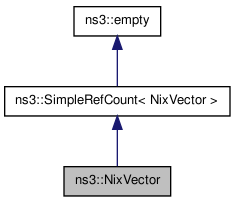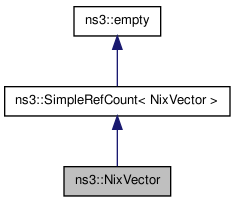Neighbor-index data structure for nix-vector routing. More...
#include <nix-vector.h>


Public Member Functions | |
| Ptr< NixVector > | Copy (void) const |
| NixVector (const NixVector &o) | |
| NixVector & | operator= (const NixVector &o) |
| void | AddNeighborIndex (uint32_t newBits, uint32_t numberOfBits) |
| uint32_t | ExtractNeighborIndex (uint32_t numberOfBits) |
| uint32_t | GetRemainingBits (void) |
| uint32_t | GetSerializedSize (void) const |
| uint32_t | Serialize (uint32_t *buffer, uint32_t maxSize) const |
| uint32_t | Deserialize (const uint32_t *buffer, uint32_t size) |
| uint32_t | BitCount (uint32_t numberOfNeighbors) const |
Friends | |
| std::ostream & | operator<< (std::ostream &outs, const NixVector &nix) |
Detailed Description
Neighbor-index data structure for nix-vector routing.
This data structure holds a vector of "neighbor-indexes" for a simulation specific routing protocol, nix-vector routing. Theses neighbor-indexes correspond to the net-device which a node should use to route a packet. A nix-vector is built (or fetched from a cache) on-demand. The nix-vector is transmitted with the packet, and along each hop of the route, the current node extracts the appropriate neighbor-index and routes the packet.
Constructor & Destructor Documentation
| ns3::NixVector::NixVector | ( | const NixVector & | o | ) |
Member Function Documentation
| void ns3::NixVector::AddNeighborIndex | ( | uint32_t | newBits, | |
| uint32_t | numberOfBits | |||
| ) |
- Parameters:
-
newBits the neighbor-index to be added to the vector numberOfBits the number of bits that newBits contains
Adds the neighbor index to the vector using a fair amount of bit manipulation to pack everything in efficiently.
Note: This function assumes that the number of bits to be added is always less than or equal to 32, ie., you can only span one entry of a nix-vector at a time. This is reasonable, since 32 bits gives you 2^32 possible neighbors.
| uint32_t ns3::NixVector::BitCount | ( | uint32_t | numberOfNeighbors | ) | const |
- Returns:
- number of bits of numberOfNeighbors
- Parameters:
-
numberOfNeighbors the total number of neighbors
This function is used to determine the number of bits of numberOfNeighbors so that this value can be passed in to AddNeighborIndex or ExtractNeighborIndex.
| uint32_t ns3::NixVector::Deserialize | ( | const uint32_t * | buffer, | |
| uint32_t | size | |||
| ) |
- Returns:
- zero if a complete nix-vector is not deserialized
- Parameters:
-
buffer points to buffer for deserialization size number of bytes to deserialize
The raw character buffer containing all the nix-vector information is deserialized into this nix-vector.
| uint32_t ns3::NixVector::ExtractNeighborIndex | ( | uint32_t | numberOfBits | ) |
- Returns:
- the neighbor index
- Parameters:
-
numberOfBits the number of bits to extract from the vector
Extracts the number of bits specified from the vector and returns the value extracted
Note: This function assumes that the number of bits to be extracted is always less than or equal to 32, ie., you can only span one entry of a nix-vector at a time. This is reasonable, since 32 bits gives you 2^32 possible neighbors.
| uint32_t ns3::NixVector::GetRemainingBits | ( | void | ) |
- Returns:
- number of bits remaining in the nix-vector (ie m_total - m_used)
| uint32_t ns3::NixVector::GetSerializedSize | ( | void | ) | const |
- Returns:
- the number of bytes required for serialization
| uint32_t ns3::NixVector::Serialize | ( | uint32_t * | buffer, | |
| uint32_t | maxSize | |||
| ) | const |
- Returns:
- zero if buffer not large enough
- Parameters:
-
buffer points to serialization buffer maxSize max number of bytes to write
This nix-vector is serialized into the raw character buffer parameter.
The documentation for this class was generated from the following file:
- src/common/nix-vector.h
 1.7.1
1.7.1